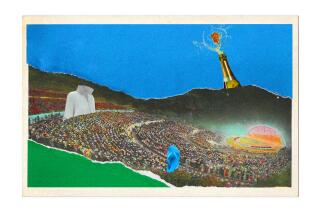Hall of Fame Isn’t Really Bowling Them Over
- Share via
ST. LOUIS — Don Carter may have thrown just as many strikes over his career as Bret Saberhagen. And Dick Weber certainly had a better hook.
Yet the achievements of these two athletic heroes and others of their profession are going virtually unnoticed despite the fact a building erected only a year ago to honor them stands less than a fungo blast away from Busch Stadium.
The National Bowling Hall of Fame and Museum, located across the street from the home of the St. Louis Cardinals, is having problems attracting spectators despite the large number of out-of-towners flocked to this city to see the recent World Series.
“I think one of our problems is that bowling is going through an image problem right now,” says Ed Marcou, publicity and promotions director for the Hall of Fame. “We don’t have the Madison Avenue clout. The Bowling Proprietors of America is headquartered in Dallas. There’s no question that if it were in New York we’d be getting more publicity.
“Frankly, I thought we’d be getting more people with the World Series in town, but I guess everybody is so immersed in the Series that they’re thinking only about baseball.”
Built at a cost of $7 million, the Bowling Hall of Fame opened its doors on June 2, 1984, and attracted about 30,000 in its first year. It did fairly well this past summer when tourism was high, but there are still too few people who know about it.
Part of the problem, too, is that bowling is more of a participation sport than a spectator sport. There are eight million people in the United States who bowl in organized leagues, yet it’s doubtful very many of them ever heard of Andy Varipapa or Marion Ladewig, two of bowling’s all-time legends.
It doesn’t exactly have the same nostalgic appeal as the Baseball Hall of Fame at Cooperstown, N.Y., or the Pro Football Hall of Fame at Canton, Ohio, even though it is the third oldest Hall of Fame in existence with its roots dating back to 1941.
Next to baseball, though, bowling may well be the most traditional in St. Louis history. At one time when team bowling flourished in the 1940s and 1950s, the Budweiser team was nationally famous and all the other large breweries sponsored powerful teams.
In fact, the Anheuser-Busch brewery contributed $500,000 to the construction of the Hall of Fame. Largely because of the brewery’s offer, St. Louis was selected as the site for the Hall of Fame over Akron by a slim 9-8 vote of the American Bowling Congress board of Directors.
St. Louis is also the original home of the Women’s International Bowling Congress, founded in 1916, and the birthplace of Carter, maybe the greatest bowler of all-time and, according to Marcou, a player who had the same impact on bowling that Babe Ruth did on baseball.
Although it lacks the prestige of the baseball, football and basketball Halls of Fame, a visit to the Bowling Hall of Fame is a pleasant way to spend an afternoon.
It is well-organized, interesting and fun and, except for the Basketball Hall of Fame at Springfield, Mass., is the only Hall of Fame that allows you to participate in the sport. There are four modern and four old-fashioned lanes in the lower level of the museum and visitors can try their hand at either. One lane is devoted entirely to duckpins.
The Hall of Fame is made up nine major separate sections which, when combined, are thoroughly informative about the sport’s past and present.
Did you know, for example, that Martin Luther, leader of the Protestant reformation, liked to bowl and would use bowling references in some of his speeches? Luther once reminded that “in ordinary life many a person thinks he can defeat others by knocking down all nine pins and then misses all of them.”
Or did you know that William Penn, founder of Pennsylvania, loved bowling and its scoring rules so much that he often wrote about it in his personal letters?
The Hall of Fame also offers other fun gimmicks, such as Hometown Heroics, a computer center which enables the visitor to find the names of every bowler who has ever recorded a perfect 300 game or an 800 series at the push of a button.
Then there’s Star Talk, an ultra modern videodisc program which enables visitors to watch famous bowlers give tips and talk about their careers.
There’s also the humorous, such as a quilt made by Don Carter’s mother from his old bowling shirts and the world’s only automobile in the shape of a bowling pin.
Now, there’s a couple of things you’ll never find at Cooperstown.
More to Read
Go beyond the scoreboard
Get the latest on L.A.'s teams in the daily Sports Report newsletter.
You may occasionally receive promotional content from the Los Angeles Times.










